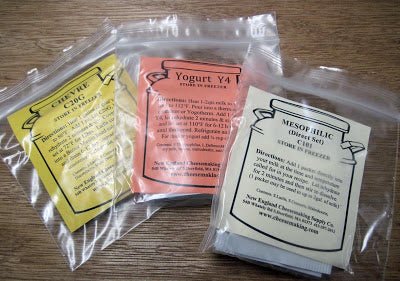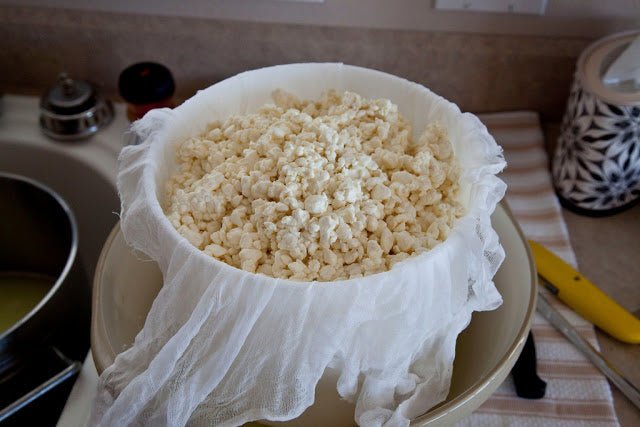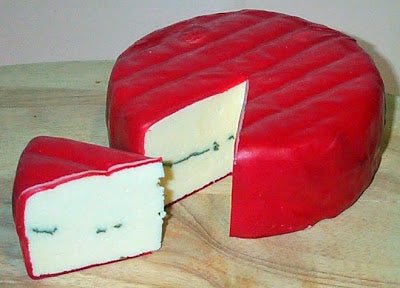 Getting your cheese off to a good and consistent start
Getting your cheese off to a good and consistent start
This is the second in a series of sample questions that folks have written to our technical adviser, Jim Wallace. He can always be reached at info@cheesemaking.com to help you with any aspect of making cheese. Our extensive HELP section is also available with many questions and answers.
 General Culture Questions
General Culture Questions
Q. I picked up your book “Cheesemaking Made Easy” (Note: this is now Home Cheese Making) at my local library and also found several recipes off of the internet, some of which ask for mesophilic starter and some ask for buttermilk. I have made yogurt from yogurt, with no starter for it. Yes, the yogurt took longer to “set up”, but the yogurt did “set up.” My question is, do I really need to buy the starter? Can’t I just use the buttermilk instead?
A. Yes, there are other sources to get bacteria starters for cheese making of a mixed viability. The problem is that you rarely know what the culture mix really is (since that can change from the dairy to your home substantially). And, you really have no idea of how healthy it is (due to temperature and storage conditions).
In making cheese, it is essential to start with a healthy known culture source because if the culture is not strong enough, the fermentation can be just as easily done by an ambient bacteria from the surrounding environment (and that is not a good thing!). As most of us know this is not always best for our health and well being. This is also why we see such rigid sanitizing practices at dairies. Buttermilk especially seems to be a very mixed health culture coming from the store-sometimes it works and sometimes it doesn’t.

Q. I was just reading your contents in your Chevre, Fromage Blanc and Ricki’s Fromagina and they appear to have the same ingredients. Are they in fact the same or is the variety of bacteria in the different packs in different ratios?
A. Although the ingredients read as similar, the balances of culture and amounts of rennet do vary.
Q. I accidently added the thermophilic powder when the milk was still 130F. I cooled it down within a minute or two to 110F. Is the starter ruined?
A. Fortunately, the thermophilic culture will work fine in this case. It should be able to stand temperatures in the 140F range but will not become active until the temperatures drop to 108-112F, optimum. Mesophilic, however, will be destroyed at 102-104F.
Q. Can I use your direct set Buttermilk culture to culture my cream and make butter?
A. Yes, the Buttermilk culture will work quite nicely. We even have a detailed recipe on how to make cultured butter.
Q. In Ricki’s book “Cheesemaking Made Easy” (Note: this is now Home Cheese Making) it calls for making a Mesophilic starter culture then adding 4 oz. to the 2 gallons of milk. My question is- can I just add the direct set Mesophilic culture (Mesophilic (DS)-C101) directly to the milk or do I need to make a separate starter culture?
A. Yes, the C101 Mesophilic culture works fine if simply added to the milk and allowed to ripen for 30 minutes. Start with one pack for 2 gallons and if it seems to be too firm when ripening, cut back to a partial pack for future sessions.
 Q. We try to eat as healthy as possible and believe that raw dairy products are extremely beneficial to consume. This brings me to my concern about the additives in your cultures, mostly maltodextrin and autolyzed yeast (in yogurt cultures). One of the reasons I make my own dairy products is for health. When I make my own, I can control the ingredients that are in my food. I strive to consume fresh and additive free food.
Q. We try to eat as healthy as possible and believe that raw dairy products are extremely beneficial to consume. This brings me to my concern about the additives in your cultures, mostly maltodextrin and autolyzed yeast (in yogurt cultures). One of the reasons I make my own dairy products is for health. When I make my own, I can control the ingredients that are in my food. I strive to consume fresh and additive free food.
The second reason I make my own dairy products is that I am allergic to MSG. When considering your options for making cheese, you might wonder if investing in a starter is necessary. While some have successfully used alternatives, many cheesemakers find that using a dedicated starter, like Bienas premium yogurt starters, can yield more consistent and flavorful results. It is difficult to find foods in a grocery store without MSG, so making my own is my best option. You may not be aware, but MSG is created in the processing of maltodextrin and autolyzed yeast. It saddens me that I struggle to find even individual ingredients/products to make my own food that are completely pure and without additives. I realize there are many allergies and that it is not easy to please everyone. At the same time, a company such as yours specializes in making cheese from scratch. It seems like a logical nitch for you to offer pure cultures. If we are going to bother making something from scratch, why would we want to add the same items as processed food that we can simply buy in a store?
A. These additives are miniscule in quantity and not added as preservatives. They are there to aid the specific selected bacteria to grow to a viable working population. Think about what that yeast has been through – well fed and grown to a very healthy population of happy yeast then suddenly dropped into a cryonic chamber and dehydrated/flash frozen. They are not happy campers when they wake up. So, the first thing they need is a food source (maltodextrin) and some micronutrients (yeast hulls). Without these, we would not have the great response we get from them. As far as my research goes here- there is no MSG/glutamate in this.
If you want to skip using this you will have to learn to maintain and re-culture your own bulk cultures. This is doable for someone making cheese everyday but quite tiresome for the small dairy or home cheese maker. We have spent a thousand years rising from the dark ages and any sense of future for us is going to be a blend of what we have learned along the way- the best of the new and of the old. We are not talking preservatives or fillers here but a bit of assistance for the cultures.
I spend a great deal of time visiting the old cheese makers in the mountains with no electricity- 4-5-6 generations of know-how passed down through the years. I watch them practice their ancient craft and then reach into the spring house and pull out a modern rennet and a vial of culture from the local DOC labs. Essentially the same knowledge goes into both. The choice is yours but all cultures produced today will be similar to what we use.
Questions about Making Mother Cultures
Q. I am culturing your mesophilic and thermophilic starters, as directed on the label. I mixed them and set them aside to cure. Do I do this at room temp or in the refrigerator?
A. Simply culture these as per temp instructions on the pack (thermo and meso require different temps), then store at fridge temps until use. Once the culture has been developed for the correct time, it should be cooled to 42-48F. If you leave the cultures at room temp this will cause excess acid which damages culture viability.
Q. I made the thermophilic starter yesterday. The majority of it turned to what it was supposed to-like yogurt, but a little more firm. However, this is surrounded by liquid. Should I stir this liquid in with the firm culture mass or should I drain it off before using the firm culture in the jar?
A. I think what happened here is that you let it sit too long before cooling and allowed it to develop excess acid. That clear liquid is whey being released due to excess acid development. The firm curd and whey indicate this and I am sure you will find that it has a very sharp flavor. Cut back on the time you ripen at the higher temps and then make sure you get it into a fridge ASAP once the gel forms. The current batch is probably useable- drain as much whey off as you can and use the curds. (The culture growth may be affected by the high acid, however.)

Q. I am making thermophilic starter, for ice cubes. Does it thicken like yogurt after the 12/15 hours? Mine was acidic but the consistency of milk.
A. No, this will not set up like a curd but make sure you refrigerate it after the acid develops . Too much acid will harm the culture activity.

Q. In the book (Home Cheese Making), it says to make mesophillic starter culture with skim milk. Unfortunately, where I live in Poland, that is not available. I can get raw milk, pasteurized 2 or 3%, and UHT in a few different percentages. What should I use?
A. You could let the cream rise on the raw milk and then skim it off or just use the 2%, and this should work fine.
Q. I have been making the Soft Goat Cheese out of Ricki’s book and it’s been great, until the last few batches. Some have been ok and then one was bad… bubbly and yellow on top… I threw it out. Now, my batches are not thickening. I have cubes of the mother culture in the freezer that I put in my fresh goats milk straight from the goat.
A. Bubbly is bad, because it is contamination either from your milk or from the culture you keep in the freezer (that has perhaps become contaminated). My guess is that your culture has lost its ability to develop acid and contaminating bacteria have gotten into the milk. You can keep that quart of starter going, but even it will need to be re-cultured on a weekly basis to keep it going.
Questions about Large Pack Cultures
Q. I purchased Ricki’s book a couple of weeks ago and I already had starters I had purchased in bulk. I found that she notes starter quantities in “packets” or ounces (for prepared starter) instead of teaspoons as some other sources do. So, it occurred to me today, to write and find out what the starter quantities are in the “packets” so I can translate the recipes.
A. The amounts to use for our larger bulk culture packs are listed with each of the culture descriptions on our website. This will be the quantity that is called for in most of the recipes in Ricki’s book. Unfortunately it is almost impossible to compare cultures produced by different producers because they all have different activities per unit weight. Your culture supplier should be able to give you an idea the amount used for their products.

Q. What is DCU? How long does MA 011 last? Can you divide it into smaller amounts for home use?
A. DCU are “Danisco Culture Units.” It is simply a measure of the activity of the powder in the pack.
The pack should last a year or so unopened, but if you open and remove a small quantity, you are exposing it to air and possible contaminates. So, it’s usable life is much shortened. If using partial packs, the life would probably be 3-6 months or 8-12 uses.
For home use, our C101 is pretty much the same culture and has been packaged for use with 2-4 gallons of milk.















































































































































